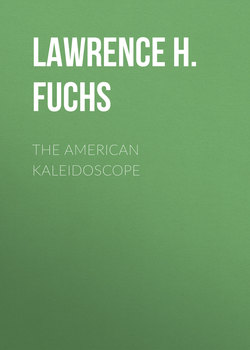Читать книгу The American Kaleidoscope - Lawrence H. Fuchs - Страница 16
На сайте Литреса книга снята с продажи.
ОглавлениеPart Two
OUTSIDE THE CIVIC CULTURE
The Coercive Pluralisms
The American minorities can be placed on a kind of color wheel. For example, when we think of the American boy, we don’t usually think of a Spanish, Turkish, a Greek or a Mexican type, still less of an Oriental type. We usually think of someone who is kind of a cross between the Teuton and the Celt.
—JAMES BALDWIN
European immigrants and their children, most of whom enthusiastically embraced the civic culture and its system of voluntary pluralism, kept non-Europeans from membership in the American polity by maintaining other systems of pluralism. The first such system was tribal pluralism. Euro-American settlers regarded native American Indians as different and lesser creatures, living in different societies, worshiping different gods, embracing different myths. Sometimes Indians were receptive to the European newcomers: Indians* along the Carolina coast were friendly in their first encounters with the Europeans. Other Native Americans were hostile, as when Powhaton captured John Smith near Jamestown in 1607. Some whites were assimilated into Indian tribes, and some Native Americans assimilated into Euro-American society. But, generally, the boundaries between them were rigidly maintained by mutual desire.
Indians often resisted the presence or incursion of whites, and most of the whites believed the Indians were savages. With Euro-Americans gaining in numbers and power, they were in a position to decide whether tribal pluralism would be based on mutual accommodation and negotiation or on force, and they increasingly opted for force. Native Americans, with few exceptions, did not seek admission to the Euro-American civic culture. Whites could not enslave the Indians or otherwise compel their labor, and they did not want them to mix in their own society.
One of the most fundamental constants in human history is the desire of insiders to arrange for outsiders—“outside” usually marked by ethnicity, language, religion, or some combination of these—to do the most menial work. Euro-Americans imported African slaves, thereby creating a coerced labor force of blacks* and their descendants throughout most of American history under a system of slavery, of involuntary caste pluralism. Spokespersons for African-Americans, who had lost their ancestral African cultures, talked repeatedly with bitterness of their exclusion from the civic culture and, for the most part, claimed their right to belong to it. Native Americans, while defeated and oppressed, remained in their own cultures. Caste pluralism, in the form of slavery, was maintained in the South up to Emancipation and in the form of severe segregation up to the Second World War and beyond. Its effects lingered even after systematic segregation was substantially dismantled everywhere.
Sojourner pluralism, a system designed by Euro-Americans for immigrants regarded as temporary residents, was applied principally to two groups of non-European immigrants in the West and Southwest. Established after the Civil War and in the decades that followed, this form of pluralism was intended to meet the labor needs of an expanding American economy without having to admit nonwhite immigrant laborers to the civic culture. Workers from the Far East, who were kept ineligible for citizenship, were expected to return home following their terms of labor. Workers from Mexico were permitted to come back and forth across the border, moving north as American employers sought their labor, then were encouraged or compelled to return south as the demand for their labor diminished.
Sojourner pluralism was far less restrictive than caste pluralism, and the children of sojourners who remained to become settlers for the most part entered the civic culture and its system of voluntary pluralism in a fashion similar to the children of European immigrant settlers. Like them, they embraced the American founding myth, with its dream of opportunity for all based on equal rights. African-Americans also treasured that ideal. Writing in 1903, W. E. B. Du Bois said there were “no truer exponents of the pure human spirit of the Declaration of Independence than the American Negroes.”1 But blacks were denied the promise of the Declaration.
The white Anglo-Saxon charter members of the government of the United States had created an idea of national membership based on equal rights for all, but the systems of sojourner pluralism and, to a much greater degree, that of caste pluralism contradicted that ideal. Not until the 1960s–1980s would the Euro-American determination to maintain a racially exclusive civic culture be abandoned.
*The term “Native Americans” is preferred over “Indians” by the leaders of many North American tribes. I use both terms in this book, and prefer “Indians” where I wish to distinguish native American Indians from Aleuts, Eskimos, and Hawaiians, who also settled in what is now the United States long before the Europeans arrived.
*In this book, I use the term “blacks” extensively, for reasons that are made clear in chapter 9, and also occasionally “Negroes,” the term preferred by most blacks in the first sixty-plus years of this century. I personally prefer the term “African-Americans,” having taught a course on the African-American experience at Brandeis for many years, and I often use it here. That term is apparently coming into wider use.
